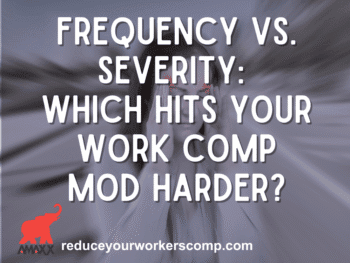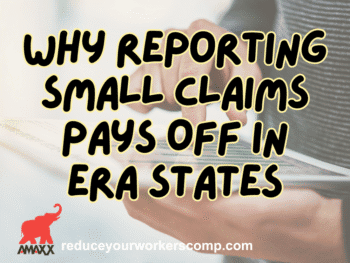A lot of employers strive to be a safer, more productive workplace for their employees. Every business would love to reduce costs and increase profit margins. The cost of workers’ compensation claims can have a significant impact on the company bottom line, particularly if you are self-insured or self-administered.
So how do you get started? Where do you start, or better yet when do you start? The answer is RIGHT NOW, and here is how:
Click Link to Access Free PDF Download
“How to Calculate Your Minimum Experience Mod, Controllable Premium & the Revenue Impact”
-
Know Where Your Risk Lies
Observe your workplace. Go through department statistics and see how they all compare to each other regarding losses. Perhaps 75 percent of your injuries occur in the shipping department. Go down there and talk with the supervisor. Find out what their issues are and why they think injuries are happening. Then, work together to solve the problem.
Another helpful thing to look at is your loss run. Talk to your carrier or adjuster and see if they notice any trends in injuries, or which people are getting injured. Maybe the newer hires account for a lot of the injuries. This may show that a focus needs to be directed towards training and safety right from day one of their employment.
Look at your business. What do you do? What are the risks involved? You could have risk in several areas, stretching from workers comp to automotive issues with your fleet and the drivers, to liability risk from customers in your store. Break it all down, and start to track your statistics. Identify issues, and work on thinking of ways you can reduce your injuries or occurrences from happening in the first place.
-
Plan Your Attack
If you have identified a few areas in which you could improve by reducing injuries or claims reports, what do you do to fix it?
The answer lies in the resources you have all around you. The first step is to talk to your carrier. Chances are they have the loss-prevention specialists ready to help you work with what needs to be fixed, and how to fix it. Ergonomic professionals can be brought in to address your workstations, and suggest possible solutions to reduce exposure.
Utilize your medical clinic contacts to see if occupational physicians can watch employees doing their work to identify potential issues with certain movements or repetitive motion injuries. Or, maybe it’s time to consider having your own in-house occupational clinic for a proactive strategy. Utilize your local council, and have them come in to explain the risks and costs associated with potentially serious injuries, automotive accidents, failure to drug test your employees, etc. Any or all of these will help you get to your goal of reducing your exposure.
FREE DOWNLOAD: “How to Calculate Your Minimum Experience Mod, Controllable Premium & the Revenue Impact”
-
Implement Your Solution Plan
Once you have identified what needs to be fixed, and how it should be fixed, now it is time to fix it. Get rid of that old equipment and bring in new equipment that has better safety features. They cost less to maintain and repair, and they are quicker to operate. Most new machines use less energy than the old ones, reducing your utility bills and creating worker ease of operation. Get some padding on the floor for workers to stand on during work at their workstations (also known as “fatigue mats”). This reduces strain on their feet and legs, and reduces body fatigue, potentially making them more productive after long hours at the workplace.
Whatever the fix may be, get it done — out with the old, in with the new.
-
Measure Your Success Statistics
Once new equipment is installed, and in place, it is time to measure your reductions. Measure your numbers in a two, four, and six-month stretch. Did you see any drop in claim activity? Did claims increase, making your plan backfire? You have to see how you did, and most importantly, you have to give it time. Change is disruptive to employees, but they will get used to it. Give it time, and measure your numbers post-change against the ones you first noticed back when you were figuring out where your risk was coming from.
-
Get feedback from your workers
After all, you have done, you left out the most important thing: To talk to your staff of workers about the changes. How do they feel it impacted their workday? Were the changes helpful, or did they hurt production? How do they feel at the end of the day? Do they feel less sore or are the new workstations worse than the old ones?
Ask as many questions as you can. This makes your staff feel that their input is important, and taken into account. After all who better to talk to about the changes that were implemented than those who were directly affected day after day?
Summary
It is hard to break old habits and accept change. Even though it is hard work to find out what your risks are, how to attack them, implementing your changes, measuring your success, and getting worker feedback, in the end, it will be worth it. Lean into the task; don’t try to tackle it all at once.

Author Michael Stack, CEO Amaxx LLC. He is an expert in workers’ compensation cost containment systems and helps employers reduce their workers’ comp costs by 20% to 50%. He works as a consultant to large and mid-market clients, is a co-author of Your Ultimate Guide To Mastering Workers Comp Costs, a comprehensive step-by-step manual of cost containment strategies based on hands-on field experience, and is founder & lead trainer of Amaxx Workers’ Comp Training Center .
Contact: mstack@reduceyourworkerscomp.com.
Workers’ Comp Roundup Blog: https://blog.reduceyourworkerscomp.com/
©2018 Amaxx LLC. All rights reserved under International Copyright Law.
Do not use this information without independent verification. All state laws vary. You should consult with your insurance broker, attorney, or qualified professional.
















